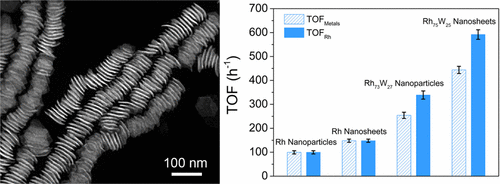Recently, the research group of Prof. Zeng from Hefei National Laboratory for Physical Sciences at the Microscale & School of Chemistry and Materials Science has applied quantum confinement and alloy effect in CO2 hydrogenation to achieve remarkable catalytic activity by fabricating RhW Nanocrystals as a catalyst. The d-band center and surface negative charge density generally determine the adsorption and activation of CO
2, thus serving as important descriptors of the catalytic activity towards CO
2 hydrogenation. Herein, researchers engineered the d-band center and negative charge density of Rh-based catalysts by tuning their dimensions and introducing non-noble metals to form an alloy. This work has been published on Nano Letters (Nano Lett. 2017, 17, 788-793) with the title of The fixation and reduction of CO
2 into useful chemicals and fuels have attracted tremendous interest to meet current energetic and environmental demands. Considering the high stability of a CO
2 molecule, activation of CO
2 plays a pivotal role in the chemical transformation of CO
2. This process can be realized through heterogeneous catalysis where the catalytic performance is largely determined by the electronic properties of the surface. Based on theoretical studies, tuning the dimension of nanostructures represents an effective strategy to engineer the surface electronic properties by varying the spatial distribution of electrons. Another strategy for electronic modification is to form an alloy by adding another metal; charge transfer will then occur owing to the different electro negativities of the constituent metals.
Herein, researchers combined these two strategies to tune the electronic properties of Rh-based nanocrystals in order to enhance the catalytic activity towards CO2 hydrogenation. During CO2 hydrogenation, RhW nanosheets exhibited remarkable catalytic activity with the turnover frequency (TOF) number of 592 h-1, which was 5.9, 4.0, and 1.7 times as high as that of Rh nanoparticles, Rh nanosheets, and RhW nanoparticles, respectively. Mechanistic studies reveal that the remarkable activity of RhW nanosheets derives from the integration of quantum confinement and alloy effect. This approach paves the effective way to modulate the electronic properties of catalysts to achieve superior catalytic performance.

Fig. RhW nanocrystals and their catalytic performance (By ZENG Jie)
This work was supported by MOST of China, the National Natural Science Foundation of China, etc.
The research group is from Hefei National Laboratory for Physical Sciences at the Microscale & School of Chemistry and Materials Science. And master student ZHANG Wenbo and doctor student WANG Liangbing contributed equally to this work. This work was supported by MOST of China, the National Natural Science Foundation of China, etc.
Contact:
Prof. ZENG Jie
zengj@ustcnet.
Publication link: http://pubs.acs.org/doi/abs/10.1021/acs.nanolett.6b03967.